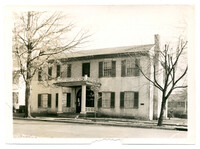
Browse Items (56 total)
Sort by:
-
W.L. Halsey and C.H. Halsey grocery store advertisements, 1896.
This is an image of page six of the Weekly Mercury from July 1896. W.L. Halsey and C.H. Halsey advertisements for their grocery stores are featured on this page. Other advertisements on this page include "C.C. Anderson Druggist", "W.R. Rison & Co. Bankers", "Sheffey & Dean", and "Herstein & Lowenthal, Proprietors." -
Testimony of a Resident of Elizabeth Routt as Requested by Abner Tate.
The author of this written statement is illegible. It appears that the first name of the author may be Francis but it being so faded, is difficult to discern. The author does state that he was living with Elizabeth Route at the time and managing her plantation, during which he became aquainted with Daniel H. Bingham. The written statement, recorded as the author was "called upon by Mr. Tate to state what my testimony was upon his trial...", details the interaction of the author with Bingham, who wished to marry Mrs. Routt, and Mrs. Routt, beginning in March 1854 through 1855. -
Statement of William W. Sanders addressed to Abner Tate.
In his statement, William W. Sanders details the day Mrs. Hazel claimed to have seen Sawyer's body being burned by Abner Tate's slaves. He tells of how she told the story to him and that he was surprised when she relayed everything to him. Sanders ends by stating he believes Mrs. Hazel charged a "man of excellent character". -
Statement of Sarah Pool.
The statement of Sarah Pool tells of her encounter with Mrs. Hazel in 1845 in Mississippi. She details the "strange stories" told by Mrs. Hazel and how she accused Mrs. McDavid of stealing and had "opened her bundle," a reference made in William Conner's letter to Abner Tate, that supposedly contained some medicines. Mrs. Hazel then asked Sarah to convey the story to Mrs. McDavid to which Sarah said Mrs. McDavid acted surprised at the accusations. Sarah also tells how Mrs. Hazel spoke of Mr. Tate and his right hand man involved in the murder of a man who she could not name. -
Statement Letter of D. H. Bingham.
This is the statement of Daniel H. Bingham taken in December of 1855 regarding a murder that occurred in Alabama that occured in 1842. In his statement, D. H. Bingham accuses Abner Tate of the murder of one Jonathan K. Rier of Tuscaloosa. He also accuses Tate's slave, George Cabiness, of aiding and abetting in the committing of the crime. Following Bingham's statement, a statement of support is taken from Barbara Hazel placing a "stranger" in the home of Abner Tate the night of the murder. The next page is a second statement given by D. H. Bingham regarding the murder of Charles B. Sawyer of Coffee County, Tennessee and accusing Abner Tate and his slave, George Cabiness of the crime. His statement is followed by the witness, Barbara Hazel's statement that placed the victim in the home of Abner Tate. -
Snapshot of the Weeden House.
The Weeden House is located at 300 Gates Avenue in downtown Huntsville. The house underwent restoration in the 1970s and is now a historic house museum and garden open to the public. -
Receipt of George W. Scott.
This receipt is from October 1, 1852 and notes Scott's wages and the price of wheat bushels. -
Proclamation from Gov. Jim Folsom announcing December 12, 1993 as Dr. Frances Roberts Day.
Folsom issued the proclamation on the same day that Roberts received an honorary doctorate from the University of Alabama in Huntsville. The text of the proclamation commends Roberts' service to the university and the community, noting that "Dr. Roberts combined her job of teaching, research and service with a much broader sense of responsibility which led her to do above and beyond what she was asked." -
Postcard of a woman, possibly Virginia Clay-Clopton, and companions.
The back of this real photo postcard reads, "Virginia Clay Clopton, age 90."









